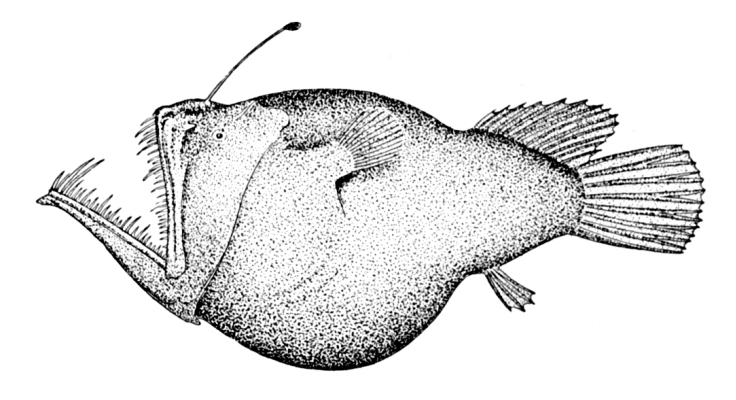Black Seadevil (Family: Melanocetidae) - Wiki Black seadevil
From Wikipedia, the free encyclopedia
[Photo] Murray's abyssal anglerfish, Melanocetus murrayi. From plate 120 of Oceanic Ichthyology by G. Brown Goode and Tarleton H. Bean, published 1896.
Black seadevils are small, deep-sea lophiiform fish comprising the family Melanocetidae. There are five known species (with only two given common names), all within the genus Melanocetus. They are found in tropical to temperate waters of the Atlantic, Indian, and Pacific Ocean, with one species known only from the Ross Sea.
One of several anglerfish families, black seadevils are named for their baleful appearance and typically pitch black skin. The family name Melanocetidae may be translated from the Greek melanos meaning "black", and cetus meaning either "whale" or "sea monster". The humpback anglerfish (Melanocetus johnsonii) was featured on the August 1995 issue of Time magazine, becoming something of a flagship species of deep-sea fauna.
Physical description
Black seadevils are characterised by a gelatinous, mostly scaleless, globose body; a large head, and generous complement of menacingly large, sharp, glassy fang-like teeth lining the jaws of a cavernous, oblique mouth. These teeth are depressible and present only in females. In some species there is a scattering of epidermal spinules on the body, and the scales (when present) are conical, hollow, and translucent. Like other anglerfish, black seadevils possess an illicium and esca; the former being a modified dorsal spine???the "fishing rod"???and the latter being the bulbous, bioluminescent "fishing lure". The esca is simple in black seadevils (with either a conical terminus or anterior and posterior ridges in some species) and both it and the illicium are free of denticles.
The bioluminescence is produced by symbiotic bacteria; these bacteria are thought to enter the esca via an external duct. (In at least two species, the esca is not luminous until this duct develops, suggesting the bacteria originate from the surrounding seawater.) The bacteria, belonging to the family Vibrionaceae, are apparently different in each anglerfish species; the bacteria have yet to be cultured in vitro.
The eyes of black seadevils are small; the pupil is larger than the lens, leaving an aphakic space. Common among deep-sea anglerfish is the strong sexual dimorphism in melanocetids: while females may reach a length of 18 centimetres or more, males remain under 3 centimetres. Aside from jaw teeth, males also lack lures. Pelvic fins are absent in both sexes. All fins are rounded with slightly incised membranes; the pectoral fins are small. The single dorsal fin is positioned far back from the head, larger than and above the retrorse anal fin.
Females have large, highly distensible stomachs which give the ventral region a flabby appearance. In life, black seadevils are a dark brown to black. The skin is extremely soft and easily abraded during collection or even by simple handling.
Life history
The Melanocetidae appear to buck the trend in deep-sea anglers, in that the males???despite not feeding and thus being little more than couriers of sperm???are free-living rather than parasitic. A brief attachment to the female does probably occur, however, as evidenced by a case of mistaken identity: A male humpback anglerfish was found attached to the lip of a female horned lantern fish (Centrophryne spinulosa) of an unrelated (though also non-parasitic) family of anglerfish, Centrophrynidae. Little else is known of their reproduction: They are presumed to be non-guarders, releasing buoyant eggs into the water which become part of the zooplankton.
While adults have been trawled from as deep as 3,000 metres, larvae appear to remain in the upper 100 metres of the water column and gradually descend with maturity. Males likely outnumber???and mature well before???females by a wide margin.
The females use their bioluminescent "fishing poles" to lure both conspecifics and prey, which include crustaceans and small fish such as lanternfish and bristlemouths; the seadevils' highly distensible stomach also allows them to swallow prey larger than themselves, which is an important adaptation to life in the lean depths. In contrast with males, females are poor swimmers and spend most of their time motionless, waiting for something to approach their lures. Predators of black seadevils are not well known, but include lancetfish.
Species
There are five species in a single genus:
Melanocetus eustalus Pietsch & Van Duzer, 1980.
Humpback anglerfish, Melanocetus johnsonii G??nther, 1864.
Murray's abyssal anglerfish, Melanocetus murrayi G??nther, 1887.
Melanocetus niger Regan, 1925.
Melanocetus rossi Balushkin & Fedorov, 1981.
http://en.wikipedia.org/wiki/Black_seadevil
| The text in this page is based on the copyrighted Wikipedia article shown in above URL. It is used under the GNU Free Documentation License. You may redistribute it, verbatim or modified, providing that you comply with the terms of the GFDL. |
